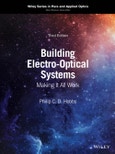In the newly revised third edition of Building Electro-Optical Systems: Making It All Work, renowned Dr. Philip C. D. Hobbs delivers a birds-eye view of all the topics you’ll need to understand for successful optical instrument design and construction. The author draws on his own work as an applied physicist and consultant with over a decade of experience in designing and constructing electro-optical systems from beginning to end.
The book’s topics are chosen to allow readers in a variety of disciplines and fields to quickly and confidently decide whether a given device or technique is appropriate for their needs. Using accessible prose and intuitive organization, Building Electro-Optical Systems remains one of the most practical and solution-oriented resources available to graduate students and professionals.
The newest edition includes comprehensive revisions that reflect progress in the field of electro-optical instrument design and construction since the second edition was published. It also offers approximately 350 illustrations for visually oriented learners. Readers will also enjoy: - A thorough introduction to basic optical calculations, including wave propagation, detection, coherent detection, and interferometers - Practical discussions of sources and illuminators, including radiometry, continuum sources, incoherent line sources, lasers, laser noise, and diode laser coherence control - Explorations of optical detection, including photodetection in semiconductors and signal-to-noise ratios - Full treatments of lenses, prisms, and mirrors, as well as coatings, filters, and surface finishes, and polarization
Perfect for graduate students in physics, electrical engineering, optics, and optical engineering, Building Electro-Optical Systems is also an ideal resource for professional designers working in optics, electro-optics, analog electronics, and photonics.
Table of Contents
Preface xxxix
Acknowledgments xliii
1 Basic Optical Calculations 1
2 Sources And Illuminators 41
3 Optical Detection 81
4 Lenses, Prisms, and Mirrors 137
5 Coatings, Filters, and Surface Finishes 165
6 Polarization 191
7 Exotic Optical Components 211
8 Fiber Optics 239
9 Optical Systems 279
10 Optical Measurements 315
11 Designing Electro-Optical Systems 343
12 Building Optical Systems 371
13 Signal Processing 405
14 Electronic Building Blocks 457
15 Electronic Subsystem Design 507
16 Electronic Construction Techniques 559
17 Digital Signal Processing 591
18 Front Ends 627
19 Bringing Up the System 665
20 Thermal Control 695
Appendix A Good Books 735
A.1 Why Books? 735
A.2 Good Books for Instrument Builders 735
Notation 743
Physical Constants and Rules of Thumb 745
Index 747








